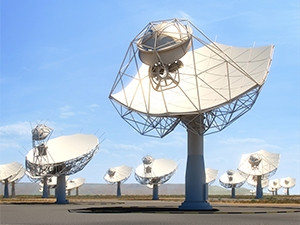
There is an impasse between the Square Kilometre Array (SKA) SA and the local aviation industry over the restriction of some radio frequencies within the Karoo.
A draft Astronomy Geographic Advantage (AGA) Act has been published for public comment, seeking the protection of the SKA from radio interference. The frequency spectrum that is referred to in the AGA is from 100MHz to 25.5GHz.
About 131 500ha of land surrounding the telescope's 176-dish core, which lies 80km from Carnarvon, needs to be free from radio frequency interference.
The SKA, to be hosted in SA and Australia, will be the world's largest radio telescope - a hundred times bigger than any current radio telescope - and is set to revolutionise the world's understanding of the universe.
The giant radio telescope will operate over a wide range of frequencies and promises to be powerful enough to detect radio waves from objects millions or even billions of light years away from Earth.
"To function at this level of sensitivity, the instrument will need to be protected from radio frequency interference," says Lorenzo Raynard, SKA SA communication manager.
Two-way communication
There have been fears that the restriction on the use of spectrum could see aircraft flying the Johannesburg-Cape Town route being redirected via Port Elizabeth, the Atlantic Ocean or over Upington.
The Civil Aviation Authority (CAA) says a restriction on the frequencies would hamper two-way communication between pilots and the relevant air traffic control sector.
However, the SKA says these draft regulations specifically recognise the importance of safety-of-life services, such as those used in the aviation sector, and provide for exemptions of these services from the strictest of the SKA protection requirements.
"The net result of these draft regulations is that commercial air traffic would not be affected," says Dr Rob Adam, SKA SA project director.
Nonetheless, he points out that as low level flight directly over the SKA could damage the sensitive SKA equipment, "we will continue to engage with the CAA to ensure this does not happen".
The SKA says a number of written representations from the aviation industry have been received in response to the public consultative process over the issue.
A meeting between the Department of Science and Technology and the Department of Transport has been proposed within the next two weeks, the purpose of which will be to provide further clarity on the proposed regulations and discuss potential impacts on the aviation industry.
Responding to ITWeb's questions, Air Traffic Navigation Systems (ATNS) spokesperson Percy Morokane said: "ATNS is part of a broader collective of stakeholders seeking a long-lasting solution to this impasse. We wouldn't want to see a situation where uncertainty strives on speculation."
Cellphone signals
SKA's Raynard explains the law and regulations still to follow will have implications on people living in astronomy advantage areas (AAA).
"AAAs that have been declared to date include the Northern Cape province, excluding Sol Plaatje Municipality; the Karoo Core AAA (consisting of 13 406 hectares of land owned by the National Research Foundation, 90km north of Carnarvon); and the Karoo Central AAAs, as published in the Government Gazette on 12 March 2014."
According to Raynard, cellphone signals will only be affected in the core area of the telescope. Communities living in the towns around the core area such as Williston, Vanwyksvlei, Brandvlei and Carnarvon will not be affected by any restrictions on cellphone coverage, he adds.
He points out the protection philosophy on which the draft regulations are based considers maximising the radio frequency spectrum available for the SKA so that the scientific work is not significantly compromised.
The regulations also aim to minimise the impact on local people as well as residual radio interference.
"The minister of science and technology published the Karoo central astronomy advantage area regulations on 23 November 2015 in the Government Gazette. The purpose of the regulation is to prohibit and restrict the use of certain radio frequency spectrum within the declared Karoo core AAA.
"All interested and affected parties were invited by the minister to send their written representations before 20 June 2016," Raynard concludes.
Share